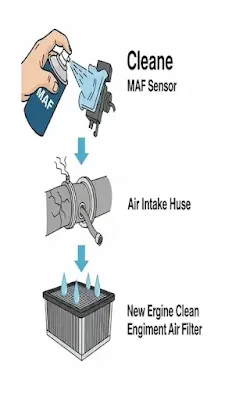💨 P0101 Code? Don't Replace Your MAF Sensor Yet.
You have a P0101 - Mass Air Flow (MAF) Circuit Range/Performance code. This is a critical point: the code does not mean your MAF sensor is dead. It means the signal it's sending is illogical or doesn't make sense compared to what other sensors are reporting.
Think of it as a disagreement. The computer sees the throttle is open a certain amount and expects a specific volume of air, but the MAF sensor is reporting something completely different. Your mission is to find out why they disagree.
🚗 How a P0101 Code Affects Your Drive
When the computer can't trust the MAF sensor, it guesses how much fuel to inject, leading to very noticeable problems:
Hesitation or stumbling during acceleration.
Rough idle or even stalling.
Poor fuel economy (MPG).
A "bogging down" feeling, as if the engine is struggling for power.
 |
| P0101 Code |
🛠️ The Smart P0101 Diagnostic Plan (Clean First!)
Before you even think about buying a new sensor, follow these steps. Over 80% of P0101 issues are resolved without replacing any parts.
1. Step 1: Clean the MAF Sensor (The #1 Fix)
The MAF sensor has a tiny, delicate hot wire that measures airflow. Over time, this wire gets coated with a thin layer of dirt and oil. This layer acts like an insulator, causing the sensor to under-report the amount of air coming into the engine.
Your Action:
Buy a can of dedicated MAF sensor cleaner. Do not use brake cleaner or anything else, as it will destroy the sensor. Carefully remove the sensor, spray the delicate wires generously, let it air dry completely (do not touch it), and reinstall it. This simple, $10 procedure solves the problem most of the time.
2. Step 2: Hunt for Air Leaks (The "Unmetered Air")
This is the second most common cause. If there is a crack or a loose connection in the air intake tube after the MAF sensor, extra air is sneaking into the engine "unmetered." The MAF measures one amount, but the engine is getting more. This causes the disagreement that triggers the P0101 code.
Your Action:
Carefully inspect the large rubber intake boot between the MAF sensor and the throttle body. Check for any cracks, especially in the accordion-like folds. Ensure all clamps are tight.
3. Step 3: Check the Engine Air Filter
A severely clogged air filter can literally choke the engine, preventing enough air from getting to the sensor. This can cause the MAF's readings to be abnormally low for a given engine speed.
Your Action:
This is the easiest check of all. Pull out your engine air filter. If it's black and filled with debris, replace it. It's a simple maintenance item that can cause real problems if ignored.
4. Step 4: Inspect the Wiring & Connector
If cleaning the sensor and checking for leaks doesn't work, the issue might be electrical. A loose or corroded connector can disrupt the signal. If all else fails, the sensor itself might have actually failed.
✨ Knowledge is Power (And Savings)
The P0101 code is a perfect lesson in smart diagnostics. Instead of jumping to the most expensive conclusion (a new sensor), a logical, step-by-step approach saves you time and money.
The MAF sensor is the first step in measuring your engine's "ingredients." That data is then used by the computer to determine the fuel mixture, which is later "tasted" by the O2 sensor a failure here can cause a P0135 heater circuit code.
Once you're sure the air is measured correctly, you need to confirm the computer knows how much you're requesting that air. That's the job of the throttle. In our next guide, we'll tackle what happens when the computer can't trust the signal from your gas pedal, triggering the [P0121 Throttle Position Sensor code].

Leave a comment